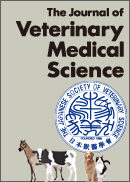Volume 81, Issue 11
November
Displaying 1-27 of 27 articles from this issue
- |<
- <
- 1
- >
- >|
Avian Pathology
-
2019Volume 81Issue 11 Pages 1597-1600
Published: 2019
Released on J-STAGE: November 29, 2019
Advance online publication: October 01, 2019Download PDF (776K)
Bacteriology
-
2019Volume 81Issue 11 Pages 1601-1605
Published: 2019
Released on J-STAGE: November 29, 2019
Advance online publication: September 20, 2019Download PDF (1005K)
Internal Medicine
-
Next-generation sequencing analysis of bacterial flora in bovine protothecal mastitic milk and feces2019Volume 81Issue 11 Pages 1547-1551
Published: 2019
Released on J-STAGE: November 14, 2019
Advance online publication: March 26, 2019Download PDF (880K) -
2019Volume 81Issue 11 Pages 1552-1557
Published: 2019
Released on J-STAGE: November 14, 2019
Advance online publication: September 25, 2019Download PDF (1197K) -
2019Volume 81Issue 11 Pages 1655-1662
Published: 2019
Released on J-STAGE: December 05, 2019
Advance online publication: October 14, 2019Download PDF (1349K) -
2019Volume 81Issue 11 Pages 1663-1670
Published: 2019
Released on J-STAGE: December 05, 2019
Advance online publication: October 02, 2019Download PDF (4256K) -
2019Volume 81Issue 11 Pages 1558-1563
Published: 2019
Released on J-STAGE: November 14, 2019
Advance online publication: September 12, 2019Download PDF (1397K) -
2019Volume 81Issue 11 Pages 1671-1675
Published: 2019
Released on J-STAGE: December 05, 2019
Advance online publication: October 11, 2019Download PDF (909K) -
2019Volume 81Issue 11 Pages 1676-1679
Published: 2019
Released on J-STAGE: December 05, 2019
Advance online publication: October 01, 2019Download PDF (1429K) -
2019Volume 81Issue 11 Pages 1680-1684
Published: 2019
Released on J-STAGE: December 05, 2019
Advance online publication: October 02, 2019Download PDF (900K)
Laboratory Animal Science
-
2019Volume 81Issue 11 Pages 1636-1642
Published: 2019
Released on J-STAGE: November 29, 2019
Advance online publication: September 16, 2019Download PDF (3303K)
Parasitology
-
2019Volume 81Issue 11 Pages 1606-1608
Published: 2019
Released on J-STAGE: November 29, 2019
Advance online publication: September 20, 2019Download PDF (794K)
Pathology
-
2019Volume 81Issue 11 Pages 1643-1648
Published: 2019
Released on J-STAGE: November 29, 2019
Advance online publication: September 25, 2019Download PDF (3586K) -
2019Volume 81Issue 11 Pages 1564-1566
Published: 2019
Released on J-STAGE: November 14, 2019
Advance online publication: September 12, 2019Download PDF (1959K)
Pharmacology
-
2019Volume 81Issue 11 Pages 1609-1615
Published: 2019
Released on J-STAGE: November 29, 2019
Advance online publication: September 27, 2019Download PDF (2877K) -
2019Volume 81Issue 11 Pages 1616-1620
Published: 2019
Released on J-STAGE: November 29, 2019
Advance online publication: October 04, 2019Download PDF (817K) -
2019Volume 81Issue 11 Pages 1621-1623
Published: 2019
Released on J-STAGE: November 29, 2019
Advance online publication: October 08, 2019Download PDF (776K)
Physiology
-
2019Volume 81Issue 11 Pages 1649-1654
Published: 2019
Released on J-STAGE: November 29, 2019
Advance online publication: October 02, 2019Download PDF (2273K)
Surgery
-
2019Volume 81Issue 11 Pages 1624-1627
Published: 2019
Released on J-STAGE: November 29, 2019
Advance online publication: September 18, 2019Download PDF (1508K)
Theriogenology
-
2019Volume 81Issue 11 Pages 1567-1574
Published: 2019
Released on J-STAGE: November 14, 2019
Advance online publication: September 13, 2019Download PDF (895K) -
2019Volume 81Issue 11 Pages 1685-1687
Published: 2019
Released on J-STAGE: December 05, 2019
Advance online publication: September 24, 2019Download PDF (722K) -
2019Volume 81Issue 11 Pages 1688-1691
Published: 2019
Released on J-STAGE: December 05, 2019
Advance online publication: October 02, 2019Download PDF (1597K)
Toxicology
-
2019Volume 81Issue 11 Pages 1575-1579
Published: 2019
Released on J-STAGE: November 14, 2019
Advance online publication: August 23, 2019Download PDF (1373K)
Wildlife Science
-
2019Volume 81Issue 11 Pages 1580-1585
Published: 2019
Released on J-STAGE: November 14, 2019
Advance online publication: September 24, 2019Download PDF (1065K) -
2019Volume 81Issue 11 Pages 1586-1596
Published: 2019
Released on J-STAGE: November 14, 2019
Advance online publication: September 24, 2019Download PDF (7242K) -
2019Volume 81Issue 11 Pages 1628-1631
Published: 2019
Released on J-STAGE: November 29, 2019
Advance online publication: October 11, 2019Download PDF (763K) -
2019Volume 81Issue 11 Pages 1632-1635
Published: 2019
Released on J-STAGE: November 29, 2019
Advance online publication: October 23, 2019Download PDF (2259K)
- |<
- <
- 1
- >
- >|
